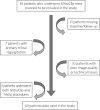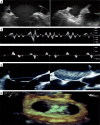EMCAPT study: the effect of MitraClip treatment on the mitral annulus and left atrial appendage evaluation by transoesophageal echocardiography
- PMID: 37090209
- PMCID: PMC10114173
- DOI: 10.5114/aic.2023.124082
EMCAPT study: the effect of MitraClip treatment on the mitral annulus and left atrial appendage evaluation by transoesophageal echocardiography
Abstract
Introduction: Data on the change in mitral valve annulus diameter (MAD), and left atrial appendage (LAA) structure and function after transcatheter edge-to-edge repair (TEER) of the mitral valve in patients with secondary mitral regurgitation (MR) are lacking.
Aim: To evaluate the change in these parameters just after the clip insertion and its relationship with prognosis in the long term.
Material and methods: A total of 50 patients (age: 71.5 ±11.3 years, 70% male) with moderate-to-severe or severe MR were included in the study. Transthoracic (TTE) and transoesophageal echocardiography (TEE) were performed before and after the procedure. Prognostic data were recorded with post-procedure telephone calls and follow-up visits.
Results: TEE performed during the procedure showed that LAA contraction and filling velocity significantly increased (p < 0.001 for all). Systolic pulmonary artery pressure (SPAP), MAD, and LAA landing zone dimension significantly decreased (p < 0.001 for all). There was only a significant correlation between the MAD before clip placement and the MAD change after clip placement (r = 0.6, p < 0.001). During a mean follow-up period of 10.5 ±8.9 months, no significant correlation was found between MAD change, LAA contraction and filling velocity change, and LAA landing zone dimension change and rehospitalization, stroke, mortality, and composite outcome.
Conclusions: The contraction and filling velocity of LAA, SPAP, MAD, and LAA landing zone dimension changed significantly immediately after the MitraClip procedure. Although these parameters are not related to composite outcome in our study, MAD, LAA diameter, and velocity need to be compared between successful and unsuccessful procedures to predict their clinical relevance.
Keywords: MitraClip; left atrial appendage; mitral annulus; mitral regurgitation.
Copyright: © 2023 Termedia Sp. z o. o.
Conflict of interest statement
The authors declare no conflict of interest.
Figures






Similar articles
-
Effect of mitral valve transcatheter edge-to-edge repair on indices of left atrial performance in chronic mitral regurgitation.Echocardiography. 2022 Nov;39(11):1420-1425. doi: 10.1111/echo.15470. Epub 2022 Oct 18. Echocardiography. 2022. PMID: 36258636
-
Spontaneous left atrial echo contrast, mitral annular systolic velocity, and left atrial appendage late emptying velocity in predicting improvement of left atrial function after percutaneous balloon mitral valvuloplasty.Echocardiography. 2018 Feb;35(2):162-169. doi: 10.1111/echo.13759. Epub 2017 Nov 26. Echocardiography. 2018. PMID: 29178504
-
Study of immediate and late effects of successful PTMC on left atrial appendage function in patients with severe rheumatic mitral stenosis IN SINUS rhythm.Indian Heart J. 2020 May-Jun;72(3):179-183. doi: 10.1016/j.ihj.2020.06.003. Epub 2020 Jun 18. Indian Heart J. 2020. PMID: 32768017 Free PMC article.
-
Prevalence of iatrogenic atrial septal defects (iASD) after mitral valve (MV) transcatheter edge-to-edge repair (TEER) in the long-term follow-up.Open Heart. 2021 Oct;8(2):e001732. doi: 10.1136/openhrt-2021-001732. Open Heart. 2021. PMID: 34702777 Free PMC article.
-
Treatment of secondary mitral regurgitation by transcatheter edge-to-edge repair using MitraClip.J Med Ultrason (2001). 2022 Jul;49(3):389-403. doi: 10.1007/s10396-022-01227-1. Epub 2022 Jun 16. J Med Ultrason (2001). 2022. PMID: 35708872 Review.
References
-
- Condado JA, Acquatella H, Rodriguez L, et al. . Percutaneous edge-to-edge mitral valve repair: 2-year follow-up in the first human case. Catheter Cardiovasc Interv 2006; 67: 323-5. - PubMed
-
- Feldman T, Foster E, Glower DD, et al. . Percutaneous repair or surgery for mitral regurgitation. N Engl J Med 2011; 364: 1395-406. - PubMed
-
- Obadia JF, Messika-Zeitoun D, Leurent G, et al. . Percutaneous repair or medical treatment for secondary mitral regurgitation. N Engl J Med 2018; 379: 2297-306. - PubMed
-
- Stone GW, Lindenfeld J, Abraham WT, et al. . Transcatheter mitral-valve repair in patients with heart failure. N Engl J Med 2018; 379: 2307-18. - PubMed
LinkOut - more resources
Full Text Sources
